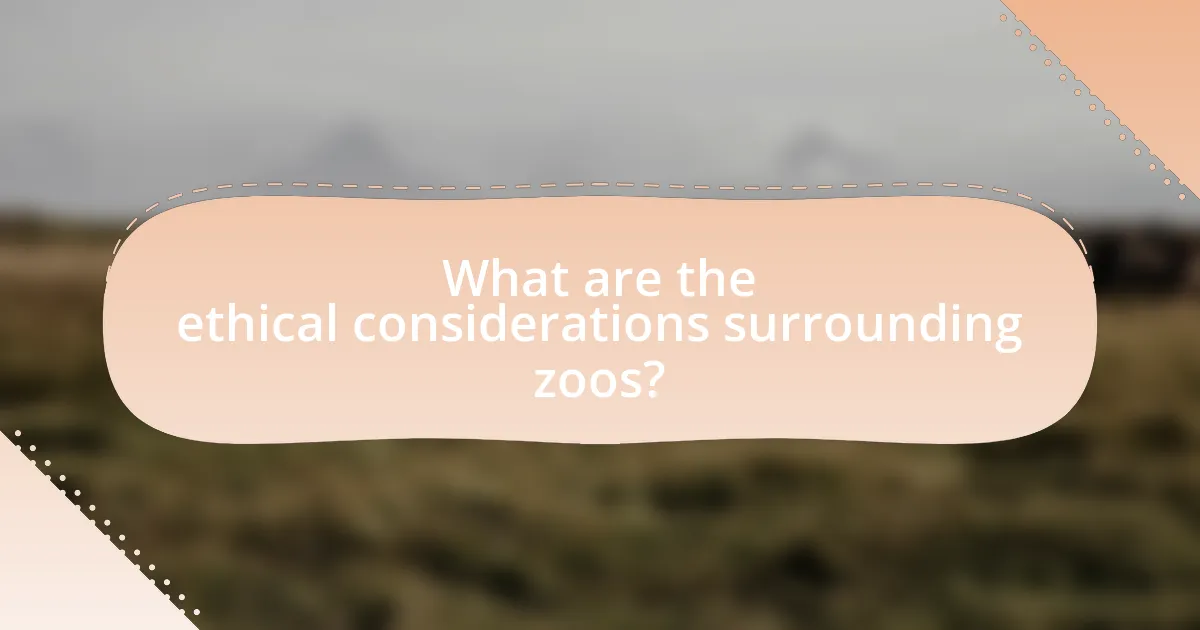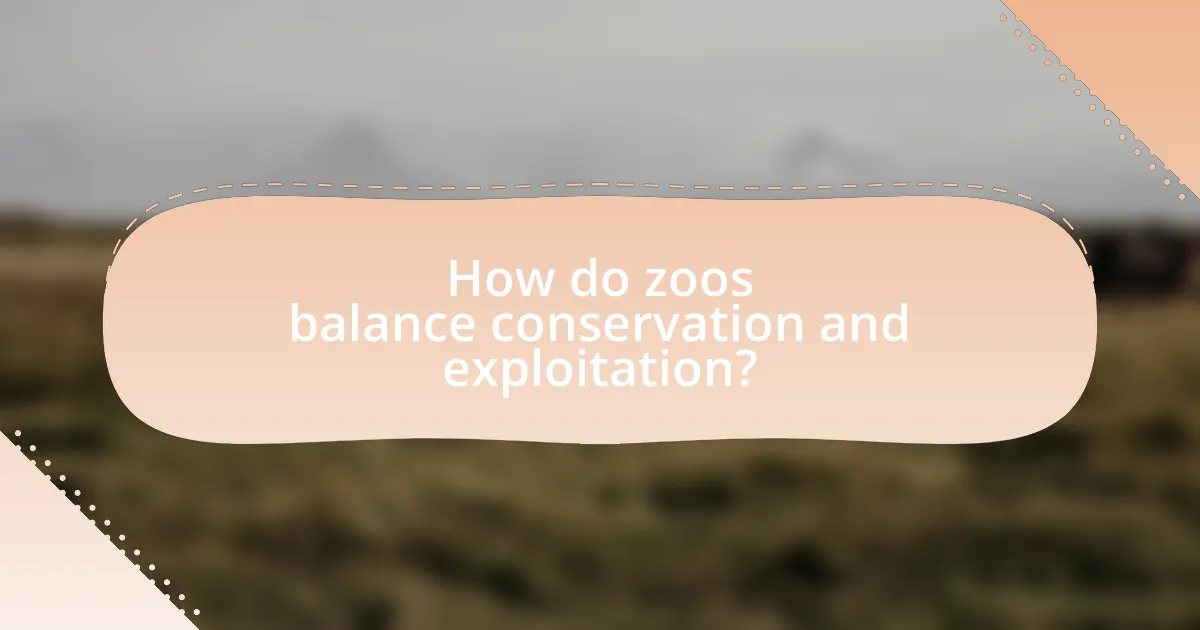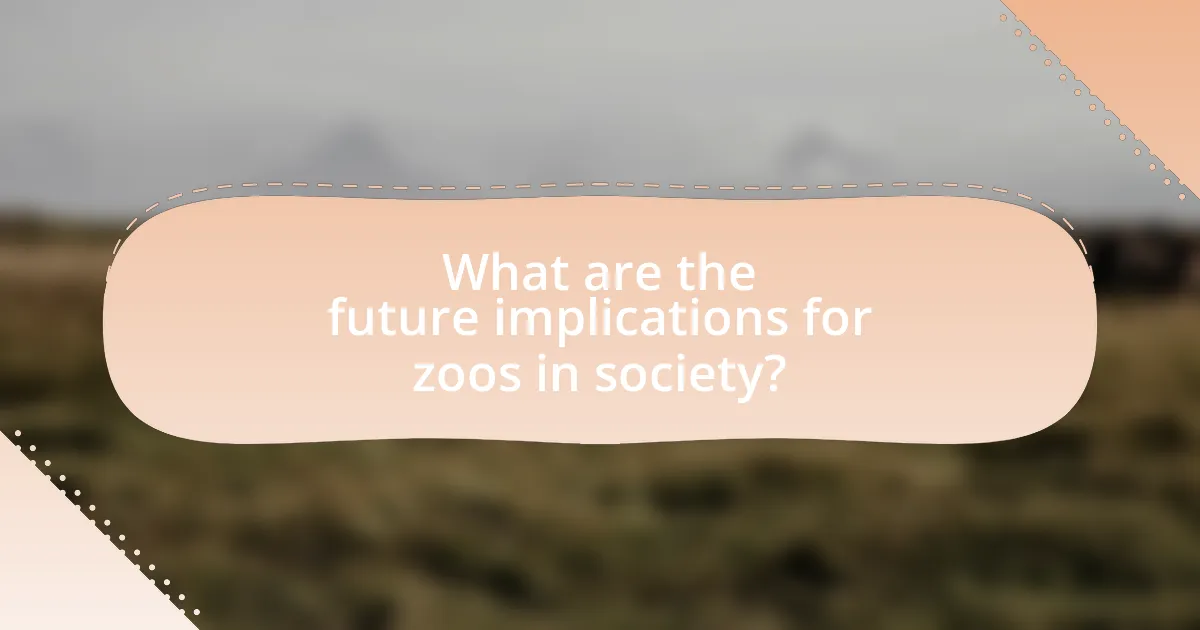The article examines the ethical considerations surrounding zoos, focusing on the balance between conservation efforts and potential exploitation of animals. It discusses animal welfare concerns, the role of zoos in species preservation through breeding programs, and the impact of public perceptions on zoo practices. Key arguments for and against zoos are presented, highlighting their contributions to conservation and education, as well as criticisms regarding animal captivity and welfare. The article also explores how zoos can evolve to meet ethical standards and enhance their conservation impact, while providing insights into best practices for supporting wildlife conservation.

What are the ethical considerations surrounding zoos?
The ethical considerations surrounding zoos primarily involve animal welfare, conservation efforts, and the potential for exploitation. Animal welfare is a significant concern, as many animals in zoos may experience stress, limited space, and unnatural living conditions, which can lead to physical and psychological issues. Conservation efforts are often cited as a justification for zoos, with claims that they contribute to species preservation and education; however, critics argue that the focus on charismatic species can overshadow the needs of less popular animals and that captive breeding programs may not effectively address the root causes of species decline in the wild. Additionally, the potential for exploitation arises when zoos prioritize profit over the well-being of animals, leading to practices such as breeding for entertainment or inadequate care. These ethical dilemmas highlight the complex balance between conservation goals and the moral responsibilities zoos have towards the animals they house.
How do zoos contribute to conservation efforts?
Zoos contribute to conservation efforts by participating in breeding programs for endangered species, which help to maintain genetic diversity and prevent extinction. For example, the Association of Zoos and Aquariums (AZA) manages Species Survival Plans (SSPs) that coordinate breeding among accredited zoos to bolster populations of species like the California condor and the black-footed ferret. Additionally, zoos engage in habitat preservation initiatives and fund wildlife conservation projects globally, contributing millions of dollars annually to protect ecosystems and species in their natural habitats. This multifaceted approach underscores the role of zoos as active participants in global conservation strategies.
What species benefit from zoo conservation programs?
Species that benefit from zoo conservation programs include endangered animals such as the Amur leopard, California condor, and black-footed ferret. These species are often part of breeding programs aimed at increasing their populations and reintroducing them into their natural habitats. For instance, the California condor population has increased from 27 individuals in 1987 to over 500 today, largely due to zoo-led conservation efforts. Additionally, zoos contribute to habitat preservation and public education, further supporting the survival of these species in the wild.
How do zoos participate in global conservation initiatives?
Zoos participate in global conservation initiatives by engaging in breeding programs, habitat restoration, and wildlife research. These institutions often collaborate with international organizations, such as the World Wildlife Fund and the International Union for Conservation of Nature, to support endangered species recovery efforts. For example, the Association of Zoos and Aquariums’ Species Survival Plan has successfully increased the populations of species like the California condor and the black-footed ferret through managed breeding and reintroduction programs. Additionally, many zoos contribute funding and expertise to in-situ conservation projects, which aim to protect natural habitats and ecosystems where these species live.
What are the arguments for and against the existence of zoos?
Arguments for the existence of zoos include their role in conservation, education, and research. Zoos often participate in breeding programs for endangered species, contributing to population recovery efforts; for example, the California condor was brought back from the brink of extinction through such programs. Additionally, zoos provide educational opportunities that raise awareness about wildlife conservation, with studies indicating that visitors to zoos are more likely to support conservation initiatives.
Conversely, arguments against zoos focus on animal welfare and ethical concerns. Critics argue that captivity can lead to physical and psychological issues for animals, as evidenced by studies showing abnormal behaviors in confined animals, such as pacing or self-harm. Furthermore, opponents contend that zoos prioritize entertainment over genuine conservation efforts, suggesting that resources could be better allocated to in-situ conservation strategies that protect animals in their natural habitats.
Why do some people view zoos as exploitative?
Some people view zoos as exploitative because they believe that keeping animals in captivity for human entertainment and education compromises the animals’ welfare and natural behaviors. Critics argue that many zoos prioritize profit over the well-being of the animals, leading to inadequate living conditions and limited space, which can cause physical and psychological stress. For instance, a study published in the journal “Animal Welfare” found that animals in captivity often exhibit signs of stress and abnormal behaviors, indicating that their needs are not being met. This perspective emphasizes that true conservation should focus on preserving animals in their natural habitats rather than confining them for display.
How do zoos address concerns about animal welfare?
Zoos address concerns about animal welfare by implementing comprehensive animal care programs that prioritize the physical and psychological well-being of the animals. These programs often include spacious enclosures that mimic natural habitats, enrichment activities to stimulate natural behaviors, and veterinary care to monitor health. For instance, the Association of Zoos and Aquariums (AZA) sets strict accreditation standards that require zoos to demonstrate their commitment to animal welfare through regular assessments and improvements in animal care practices. Additionally, many zoos engage in conservation efforts that contribute to species preservation, further justifying their role in animal welfare.

How do zoos balance conservation and exploitation?
Zoos balance conservation and exploitation by prioritizing species preservation while generating revenue through visitor engagement. Many zoos participate in breeding programs for endangered species, contributing to genetic diversity and population recovery, as seen in the successful reintroduction of the California condor, which increased from 27 individuals in 1987 to over 500 today. Additionally, zoos often allocate a portion of their profits to conservation initiatives in the wild, thus aligning their operational goals with ecological sustainability. This dual approach allows zoos to fulfill their educational and conservation missions while addressing the financial realities of maintaining their facilities and programs.
What practices do zoos implement to ensure ethical treatment of animals?
Zoos implement several practices to ensure the ethical treatment of animals, including habitat enrichment, proper veterinary care, and educational programs. Habitat enrichment involves creating environments that mimic the animals’ natural habitats, which promotes natural behaviors and mental stimulation. Proper veterinary care ensures that animals receive regular health check-ups, vaccinations, and treatment for illnesses, contributing to their overall well-being. Educational programs aim to raise public awareness about wildlife conservation and the importance of ethical treatment, fostering a connection between visitors and the animals. These practices are supported by guidelines from organizations such as the Association of Zoos and Aquariums, which emphasizes animal welfare standards and ethical considerations in zoo management.
How do zoos provide enrichment for captive animals?
Zoos provide enrichment for captive animals through various methods designed to stimulate their natural behaviors and enhance their well-being. These methods include environmental enrichment, which involves altering the animals’ habitats with structures, plants, and objects that encourage exploration and play. Additionally, zoos implement feeding enrichment, where food is hidden or presented in challenging ways to promote foraging behaviors. Research indicates that such enrichment activities can significantly reduce stress and stereotypic behaviors in animals, as evidenced by studies showing improved psychological health in enriched environments compared to barren ones.
What standards are in place for animal care in zoos?
Standards for animal care in zoos are primarily governed by guidelines set forth by organizations such as the Association of Zoos and Aquariums (AZA) and the World Association of Zoos and Aquariums (WAZA). These standards include requirements for proper habitat design, nutrition, veterinary care, and enrichment activities to promote the physical and psychological well-being of the animals. For instance, the AZA mandates that accredited zoos must provide species-specific environments that mimic natural habitats, ensuring that animals can exhibit natural behaviors. Additionally, regular veterinary check-ups and a comprehensive health management plan are essential components of these standards, which are designed to enhance animal welfare and support conservation efforts.
How do public perceptions influence zoo practices?
Public perceptions significantly influence zoo practices by shaping policies, animal care standards, and educational programs. When the public expresses concern over animal welfare or ethical treatment, zoos often respond by enhancing habitats, improving care protocols, and increasing transparency about their operations. For instance, a 2019 survey indicated that 70% of zoo visitors prioritize animal welfare, prompting many institutions to adopt more naturalistic enclosures and engage in conservation efforts. Additionally, public advocacy for species preservation has led to increased funding for breeding programs and habitat restoration initiatives, demonstrating that community values directly impact zoo management and operational strategies.
What role does education play in shaping views on zoos?
Education plays a crucial role in shaping views on zoos by informing the public about animal welfare, conservation efforts, and ethical considerations. Through educational programs and outreach, zoos can raise awareness about the species they house, the threats they face in the wild, and the importance of conservation initiatives. Research indicates that visitors who engage with educational content during their zoo experience are more likely to support conservation efforts and develop a positive perception of zoos as institutions that contribute to wildlife preservation. For example, a study published in the Journal of Zoo and Aquarium Research found that educational experiences significantly enhance visitors’ understanding of biodiversity and conservation, leading to increased advocacy for wildlife protection.
How do visitor experiences impact zoo conservation efforts?
Visitor experiences significantly enhance zoo conservation efforts by fostering emotional connections and increasing awareness about wildlife preservation. Engaging exhibits and educational programs encourage visitors to support conservation initiatives financially and advocate for wildlife protection. Research indicates that zoos that prioritize visitor engagement see higher participation in conservation programs; for instance, a study published in the Journal of Zoo and Aquarium Research found that 70% of visitors who participated in interactive experiences reported a greater likelihood of donating to conservation causes. This correlation underscores the importance of visitor experiences in driving support for conservation efforts.

What are the future implications for zoos in society?
The future implications for zoos in society include a shift towards conservation-focused missions and enhanced ethical standards. As public awareness of animal welfare and conservation issues grows, zoos are increasingly expected to prioritize the preservation of endangered species and their habitats. For instance, the World Association of Zoos and Aquariums emphasizes that modern zoos should contribute to global conservation efforts, which may lead to more collaborative projects with wildlife organizations. Additionally, advancements in technology and virtual reality may allow zoos to provide educational experiences without keeping animals in captivity, further aligning with ethical considerations. This evolution reflects a broader societal demand for responsible stewardship of wildlife and a commitment to ethical practices in animal care.
How can zoos evolve to meet ethical standards?
Zoos can evolve to meet ethical standards by prioritizing animal welfare, enhancing conservation efforts, and promoting education. Implementing larger, more naturalistic habitats improves the quality of life for animals, as studies show that enriched environments reduce stress and promote natural behaviors. Additionally, zoos can focus on breeding programs for endangered species, contributing to biodiversity and conservation, as evidenced by successful initiatives like the California condor recovery program. Furthermore, educational programs that inform the public about wildlife conservation can foster a deeper understanding of ethical practices, aligning with the growing societal demand for humane treatment of animals.
What innovations are being explored in zoo management?
Innovations being explored in zoo management include the use of advanced technology for animal monitoring, virtual reality experiences for visitor engagement, and enhanced breeding programs through genetic research. These innovations aim to improve animal welfare, increase conservation efforts, and provide educational experiences. For instance, the integration of GPS and biometric sensors allows for real-time tracking of animal health and behavior, which supports better care and management practices. Additionally, virtual reality is being utilized to create immersive experiences that educate visitors about wildlife conservation without the need for physical animal displays, thereby reducing stress on the animals.
How can zoos enhance their conservation impact moving forward?
Zoos can enhance their conservation impact moving forward by prioritizing habitat restoration and species reintroduction programs. These initiatives directly contribute to the preservation of biodiversity, as evidenced by successful cases like the California condor recovery program, which saw the population increase from 27 individuals in 1987 to over 500 today due to captive breeding and reintroduction efforts. Additionally, zoos can strengthen partnerships with conservation organizations and local communities to support in-situ conservation projects, ensuring that efforts are aligned with the needs of ecosystems and species in their natural habitats. By focusing on education and raising public awareness about conservation issues, zoos can also inspire visitors to engage in conservation efforts, further amplifying their impact.
What can individuals do to support ethical zoos?
Individuals can support ethical zoos by visiting them, as ticket sales often fund conservation efforts and animal welfare programs. By choosing to visit accredited zoos that prioritize animal care and conservation, individuals contribute to the financial sustainability of these institutions. Additionally, individuals can become members or donors, providing ongoing support that helps zoos maintain high standards of animal care and engage in vital conservation projects. Supporting educational programs and advocating for ethical practices within the community further enhances the impact of ethical zoos, promoting awareness about wildlife conservation and responsible animal care.
How can visitors make informed choices about zoo attendance?
Visitors can make informed choices about zoo attendance by researching the zoo’s conservation efforts, animal welfare standards, and educational programs. Evaluating a zoo’s commitment to ethical practices, such as participation in breeding programs for endangered species and transparency in animal care, helps visitors assess its role in conservation versus exploitation. For instance, the World Association of Zoos and Aquariums (WAZA) provides guidelines for ethical zoo practices, which can serve as a benchmark for visitors. Additionally, reading reviews and testimonials from previous visitors can offer insights into the zoo’s operations and visitor experiences, further aiding in making an informed decision.
What are the best practices for supporting wildlife conservation?
The best practices for supporting wildlife conservation include habitat preservation, sustainable practices, and community engagement. Habitat preservation involves protecting natural environments to ensure species survival, as studies show that over 80% of terrestrial biodiversity is found in forests, wetlands, and grasslands. Sustainable practices, such as responsible tourism and eco-friendly agriculture, minimize human impact on wildlife. Community engagement fosters local stewardship, as evidenced by programs where local populations participate in conservation efforts, leading to a 30% increase in wildlife populations in some regions. These practices collectively enhance biodiversity and promote ecological balance.